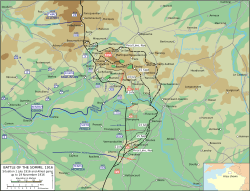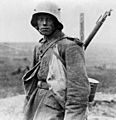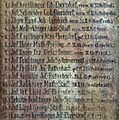Battle of Ginchy facts for kids
Quick facts for kids Battle of Ginchy |
|||||||
|---|---|---|---|---|---|---|---|
| Part of The Battle of the Somme of the First World War | |||||||
 Battle of Ginchy |
|||||||
|
|||||||
| Belligerents | |||||||
| Commanders and leaders | |||||||
| Douglas Haig Ferdinand Foch Émile Fayolle Henry Rawlinson Joseph Alfred Micheler |
Crown Prince Rupprecht of Bavaria Max von Gallwitz Fritz von Below |
||||||
| Strength | |||||||
| 3 divisions | c. 3 divisions | ||||||
The Battle of Ginchy was an important fight during the Battle of the Somme in World War I. It happened on 9 September 1916. During this battle, the 16th (Irish) Division of the British army captured the village of Ginchy, which was held by German forces.
Ginchy is a small village in France, about 1.5 kilometers (1 mile) northeast of Guillemont. It sits on a hill, giving a good view over the area, including Combles to the southeast. Capturing Ginchy was key for the British and French armies. It helped them get ready for a bigger attack planned for mid-September.
Before the main attack on 9 September, British forces had tried to take Ginchy several times. On 3 September, the 7th Division briefly captured the village but were pushed out by a German counter-attack. More attacks on 4 and 5 September also failed. The British then brought in fresh troops, including the 16th (Irish) Division, to try again.
On 9 September, the British started shelling German positions early in the morning. However, they waited until late afternoon to attack. This was a clever tactic to prevent the Germans from launching a quick counter-attack before nightfall. The British assault was successful, especially in the north where the 16th (Irish) Division captured Ginchy. This victory was important because it took away key observation points from the Germans. It also made it easier for the Allies to advance in other areas.
Why Ginchy Was Important
Controlling the Battlefield
After the British captured part of the German defenses in July, the Germans made their positions stronger. The British line formed a bulge near Longueval and Delville Wood. German positions at Guillemont and Ginchy overlooked this area. This meant German artillery could easily fire on British troops and supply routes.
The Allies needed to capture Guillemont and Ginchy to improve their position. This would allow them to see more of the battlefield and make it harder for German artillery to target them.
Planning for a Big Attack
From July to September, the British launched many smaller attacks. These were meant to wear down the German army and prepare for a large combined attack with the French. British leaders believed that the German army was getting weaker. They thought a big attack in mid-September could be a decisive moment in the war.
German divisions were losing many soldiers. British intelligence estimated that the Germans had suffered around 130,000 to 175,000 casualties by this time. This made the British confident that a major push could succeed.
Getting Ready for Battle
British Preparations
The British and French armies planned to work together to capture the high ground around the Combles valley. This would help them isolate Combles, a key German position. Fighting had been going on for weeks in areas like Delville Wood, west of Ginchy. This constant fighting put a lot of strain on British supply lines and troops.
The British planned their attack carefully. They wanted to trick the Germans about when the main assault would happen. On 9 September, they started shelling at 7:00 a.m. but didn't attack until 4:45 p.m. This was to prevent the Germans from counter-attacking before dark. The French army, who were supposed to attack on the same day, had to delay their assault until 12 September due to supply problems.
German Defenses
The Germans had also been busy strengthening their defenses. Constant shelling had turned their trenches into a mess of craters. Allied planes and artillery made it very difficult for German soldiers to move or build new defenses. The Germans had to adapt their tactics. Instead of long trench lines, they used shell-holes as outposts.
These new positions were hard to spot from the air. However, the Germans often lacked enough soldiers and supplies for quick counter-attacks. In early September, the German troops defending Ginchy were new to the area and didn't know the ground well. To make things worse, responsibility for defending Ginchy was split between two German divisions, causing confusion.
The Battle Unfolds
French Army Attacks
The French Sixth Army attacked north of the Somme River on 3 September. They captured most of Cléry and the village of Le Forêt. They also took many prisoners and guns. On 4 September, the French Tenth Army attacked south of the river, taking Chilly and Soyécourt.
On 12 September, the French Sixth Army launched a bigger attack. They captured Bouchavesnes and pushed towards Rancourt and Sailly-Saillisel. These French advances helped the British by putting pressure on the German lines from the south.
British Fourth Army Attacks
British attacks on Ginchy started on 3 September. The 7th Division tried to advance but faced heavy German machine-gun fire. They managed to get into parts of Ginchy but were pushed back by German counter-attacks. The fighting was intense, with heavy artillery fire from both sides.
On 9 September, the final attack on Ginchy began. The 56th (1/1st London) Division attacked from the southeast, while the 16th (Irish) Division attacked from the west. The 16th (Irish) Division advanced quickly, facing little resistance. They reached the western edge of Ginchy by 5:00 p.m.
Two more battalions from the Irish Division then pushed through, capturing the village and taking about 200 German prisoners. The remaining German soldiers retreated. The Irish troops then set up strong defensive lines around the eastern edge of Ginchy.
On the right side of the British attack, the 55th Division tried to capture the eastern part of Delville Wood. They took some German positions but couldn't hold them against German artillery and machine-gun fire. Several German counter-attacks in the evening were fought off.
Air Support During the Battle
Aircraft played an important role in the battle. On 6 July, British planes spotted German troops moving into Ginchy and called for artillery fire. On 3 September, reconnaissance flights over Ginchy reported on German troop movements.
During the main attack on 9 September, three British planes flew over the area. They reported on the progress of the British troops and machine-gunned German soldiers. They also used wireless to call for artillery fire on German positions. These reports helped the British commanders understand how the battle was going.
German Counter-Attacks
The Germans tried hard to defend Ginchy. On 3 September, they launched counter-attacks that pushed the British out of the village. On 6 September, another British attack got into Ginchy, but the Germans quickly counter-attacked and forced them out again.
By 8 September, the German troops defending Ginchy were exhausted. The area between Delville Wood and Ginchy was constantly shelled, turning it into a muddy mess. The German soldiers had to dig deeper into shell-holes, often finding British bodies.
On 9 September, the German 5th Bavarian Division defended Ginchy. They tried to counter-attack several times from the north of the village, but these attempts failed. The German troops got lost in the dark and faced heavy British artillery and machine-gun fire. Some German soldiers managed to get into Ginchy but were quickly overwhelmed.
What Happened Next
Soldier Losses
The Battle of Ginchy was very costly for both sides. From 7 to 12 September, the German Bavarian Infantry Regiment 19 lost 884 men. The British 16th (Irish) Division suffered 4,330 casualties from 1 to 10 September. The 7th Division lost 3,800 soldiers from 23 August to 7 September. The 24th Division also had about 2,000 casualties.
After the Battle
After capturing Ginchy, the British worked to strengthen their hold on the village. They also tried to capture the Quadrilateral, a strong German trench system nearby. On the night of 9/10 September, the 16th (Irish) Division was replaced by the Guards Division.
On 10 September, the 56th (1/1st London) Division attacked again but was stopped by German machine-gun fire. The Guards Division also fought off German attempts to retake Ginchy. The Quadrilateral was a tough target, and British attacks on it failed several times. It was finally captured by the 6th Division on 18 September. The capture of Ginchy was a key step in the larger Battle of the Somme.
Images for kids
-
Detail of the war memorial in the village of Preying (Saldenburg, Bavaria) naming Infantry Vizefeldwebel Josef Liebl who was killed during the Battle of Ginchy, 9 September 1916.





